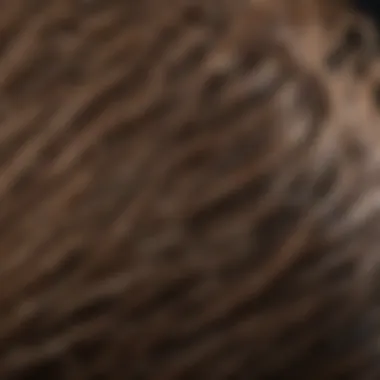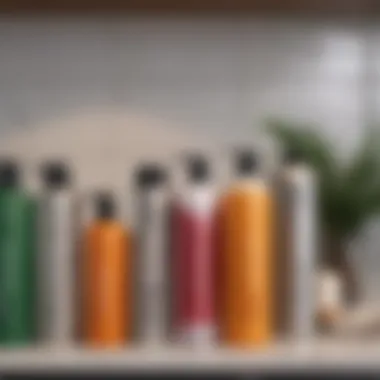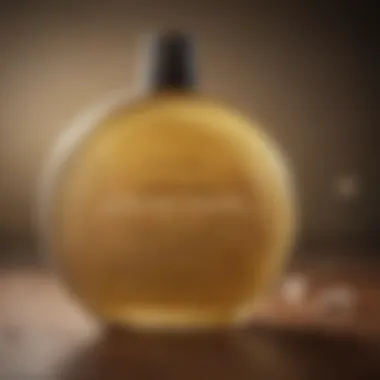Ultimate Guide to Shampoo and Conditioner for Dry Coarse Hair


Intro
This guide focuses on the specific needs of dry coarse hair and aims to provide an understanding of how to properly care for it. Dry coarse hair has certain characteristics that require special thrreatment with suitable shampoos and conditioners.
Well-Being Overview
Intro to the topic
The health of our hair plays a significant role in our overall impression of well-being. While it is often overlooked, hair texture and condition can affect our self-esteem and daily interaction with others. Dry coarse hair, in particular, has its own unique problems and needs thorough care.
Importance of focusing on this aspect of well-being
Understanding and maintaining the health of dry coarse hair is vital. This type of hair is more prone to damage, breakage, split ends, and roughness. Focusing on proper care not only benefits the hair but also contributes to mental wellness by enhancing confidence and reducing stress related to hair issues.
The Nature of Dry Coarse Hair
Dry coarse hair typically shows signs of lack of moisture. It feels rough, is difficult to manage, and may even develop a frizzy appearance. To address these issues, one must understand what defines dry coarse hair.
Characteristics
- Lower moisture content
- More prone to damage
- Appearance of frizz and split ends
Recognizing these characteristics sets the stage for choosing the right products tailored to these needs.
Understanding Hair Type
Not every hair type requires the same type of maintenance. It’s crucial to identify personal hair characteristics to opt for products that will align with its unique requirements. Focusing on hydrating and nourishing shampoos can improve overall quality.
Selected Products
When seeking shampoos and conditioners for dry coarse hair, it’s essential to focus on formulas that increase moisture retention and are free from sulfates which can strip away natural oils.
Recommended Ingredients for Shampoos and Conditioners
- Hydrating oils such as argan oil or coconut oil
- Humectants that draw moisture into the hair, such as glycerin
- Essential fatty acids to aid hair repair
Products that incorporate these ingredients often result in significant improvements in manageability and shine.
“Choosing the right shampoo and conditioner is not just a routine chore, but a necessary step towards healthier hair.”
Usage Tips
- Follow a regular washing routine while allowing for occasional skips to avoid overdrying.
- Apply conditioner generously, focusing on the ends or dry areas for maximum benefits.
Understanding Dry Coarse Hair
The journey to maintaining healthy hair begins with understanding its dynamics, especially when it comes to dry coarse hair. This hair type demands attention due to its unique characteristics and specific needs. Knowing these elements can empower individuals to make informed decisions regarding product usage and care techniques. This section examines the features of dry coarse hair, its common causes, and why appropriate shampoos and conditioners play such a crucial role in its health.
Characteristics of Dry Coarse Hair
Dry coarse hair displays an array of distinct traits. It is often rough and lacks smoothness, which contributes to a brittle appearance. Common characteristics include:
- Texture: The individual strands are thick, making hair feel shaggy and voluminous.
- Lack of Luster: Shine is minimal. This may lead to the perception of dullness.
- Brittleness: It breaks easily, exacerbated by environmental factors or improper care.
- Tangles and Knots: Due to its coarse texture, this kind of hair often tangles, becoming frustrating to manage.
These aspects highlight the importance of using suitable products that meet hydrating and nourishing requirements. Understanding these features informs not just the selection of appropriate cleansers and conditioning agents, but also defines individual care strategies for better overall results.
Common Causes of Dryness and Coarseness
The quest for optimal hair health involves acknowledging various factors that lead to dryness and coarseness. These may include:
- Environmental Factors: Exposure to sun, wind, and humidity can rob moisture from hair.
- Chemical Treatments: Products such as dyes, perms, or relaxers can contribute to hair structure damage.
- Heat Styling: Frequent use of hot tools like blow dryers and flat irons diminishes hair’s natural hydration.
- Incorrect Washing Regimens: Over-washing or compromising cleansing method can strip moisture.
By identifying the causes of dry coarse hair, individuals can tailor their approaches. Better choices around products and daily habits can mitigate damage and significantly improve hair conditions and appearance.
A deep understanding of hair characteristics and causes allows for informed choices leading to improvement.


Importance of Choosing the Right Shampoo
Choosing the right shampoo is crucial for maintaining healthy hair, particularly for those with dry coarse hair. Shampoos can impact the hair's moisture level and overall health. A well-formulated shampoo can hydrate and enhance manageability, making it easier to style and maintain.
Selecting an appropriate shampoo involves understanding the special requirements of dry coarse hair. Products should not only cleanse effectively but also avoid stripping the hair of essential oils. The wrong choice may lead to more dryness and proactive scalp irritation. Ingredients present in shampoos can either support or compromise the condition of your hair.
To optimize hair wellness, consideration of formulation is essential. Beneficial ingredients can greatly assist in preventing hair breakage, improving elasticity, and imparting a healthy shine. Additionally, recognizing harmful agents that might exacerbate existing hair issues ensures a strategy aligned with hair care goals.
The right shampoo can make a significant difference in your hair care routine.
Key Ingredients to Look For
Moisturizing Agents
Moisturizing agents are integral to shampoos targeting dry coarse hair. These components help retain hydration, preventing feelings of tightness or straw-like texture. Key characteristics of a good moisturizing agent include humectant properties, meaning they attract moisture from the environment and hold it effectively.
By incorporating compounds like glycerin or aloe vera, shampoos cater to a moisture-hungry texture. This softness enables easier styling and delivers an overall healthy appearance to hair. However, challenging conditions such as humidity can sometimes cause an excess of moisture retention, leading to a less desirable outcome.
Natural Oils
Natural oils play a significant role in addressing the dryness and coarseness of hair. Their ability to provide natural emollience makes them a popular choice in hair care formulations. Oils like argan, coconut, and jojoba can penetrate the hair shaft to nourish from within.
These oils not only condition but also shield hair from environmental stressors. Their unique trait lies in the balance they offer. While they generally do not weigh hair down, overuse, especially in heavier formulations, can result in a greasy appearance, which is undesirable.
Proteins and Amino Acids
Proteins and amino acids are essential for rebuilding the hair's structure and enhancing its strength. These components are vital for anyone dealing with dry, coarse hair as they help alleviate brittleness and potential breakage. A key characteristic of proteins such as keratin is their ability to bind with damaged areas, promoting repair.
Moreover, amino acids nourish and maintain hair, adding to its elasticity and manageability. The downside, however, is using too much protein can also lead to stiffness, making it crucial to balance with moisturizing agents in your overall hair care routine.
Ingredients to Avoid
Sulfates
Sulfates are compounds often found in various personal care items but are known to be quite harsh, especially for dry coarse hair. Their primary function entails base cleaning properties, eliminating dirt and oils. The downside is they can strip natural oils necessary for moisture retention.
Avoiding sulfates may preserve inherent humidity, reducing hair damage caused by excessive dryness. Choosing sulfate-free products can maintain a healthier hair environment which supports overall wellness.
Alcohols
While not all alcohols are harmful, those found in many formulations can dry hair excessively. They act as solvents; thus, excessive use in products can potentially exacerbate dryness and coarseness. It is wise to keep track of the types and amounts of alcohols used in formulations.
Notably, fatty alcohols are an exception as they offer emollient properties. The focus should target short-chain drying alcohols to diminish any negative actions they may impose on hair health.
Silicones
Silicones are prevalent in hair care products, often formulated to deliver smoothness and shine. Their characteristic allows for temporarily improving appearance and texture. However, they potentially lead to a build-up issue, especially in dry coarse hair lacking consistent moisture.
The underlying issue stems from them creating a barrier that prevents moisture from entering the hair shaft. Therefore, acknowledgment of silicone-based products is essential. Regular cleansing with appropriate shampoos is necessary to avoid this circumstance, particularly during prolonged usage.
Selecting the Right Conditioner
Selecting the right conditioner is crucial for managing dry coarse hair. You need more than just a leading brand; you desire products that enhance hydration, add nourishment, and improve manageability. A conditioner tailored to dry coarse hair targets the unique properties of this hair type, providing crucial benefits. Proper selection can significantly affect hair's texture and overall health.
Types of Conditioners
Rinse-Out Conditioners
Rinse-out conditioners are designed to be applied after shampooing and rinsed out after a few minutes. They are essential for adding temporary moisture and smoothing hair. One key characteristic of rinse-out conditioners is their wide laung of formulations, which can address different hair needs. Products like Pantene Pro-V and Herbal Essences can be effective choices. It’s a popular option for those looking for quick hydration, supporting the overall aim of this guide. Their unique feature is that they work swiftly; however, they may not provide long-lasting effects compared to other conditioner types.
Leave-In Conditioners
Leave-in conditioners are designed for prolonged absorption, as they stay in the hair without rinsing. This aspect allows them to offer continuous moisture, improving the ease of styling. Brands like Bumble and bumble and It's a 10 excel in providing lightweight formulas that do not weigh hair down. This makes them a beneficial choice, especially for coarse hair that requires extra hydration and care. The advantage is that they protect the hair throughout the day, but they may require a balancing act to avoid greasy appearances in some hair types.
Deep Conditioners


Deep conditioners penetrate the hair shaft more effectively than most other conditioners, delivering high doses of hydration and repair. This is especially potent for dry coarse hair that often craves attention. Products such as Ouidad and SheaMoisture feature rich, creamy textures critically needed for better nourishment. Deep conditioners are a favorite choice among those looking to restore dehydrated hair to a healthier state. They offer valuable reparative properties; however, excessive use without proper care can cause product buildup over time.
Essential Conditioner Ingredients
Hydrating Agents
Hydrating agents are crucial for replenishing moisture within hair fibers. Ingredients like glycerin or hyaluronic acid purposefully draw moisture into the hair, making them key components. These agents ensure hair feels softer and smoother. The unique feature of using hydrating agents is that they push moisture deep into dry hair. While very effective, one must ensure to select products without too sticky or thick textures, which can lead to discomfort.
Nourishing Oils
Nourishing oils like argan and coconut oil are important for their restoring properties. They help in smoothing and providing shine without heavy buildup. Their key characteristic is their ability to hydrate and soften hair, enhancing overall texture. They deeply nourish the hair while offering both protective and conditioning benefits. However, using excessively heavy oils may lead to greasiness, thus careful selection based on hair type is critical.
Vitamins
Vitamins, particularly B5 and E, provide essential nourishment to enhance hair’s health. B5 can strengthen hair and prevent breakage, while E helps encourage healthy moisture levels. The unique feature of vitamins in conditioners is their ability to proceed benefits to the hair on a cellular level, allowing for stronger and shinier hair. The advantage is not only that they condition but also that they restore essential nutrients skin and hair often lack, but overuse can prove counterproductive, leading to a buildup of unnecessary supplements.
Selecting the credential conditioner is a major step towards combating dry coarse texturing. Understanding the product types and their core components will aid in better upkeep and benefits toward healthier hair.
Understanding Hair Washing Techniques
Understanding the proper hair washing techniques is critical for maintaining healthy hair, especially if it is dry and coarse. Many individuals do not consider how their washing habits can affect their hair's moisture levels. The right techniques can enhance the effectiveness of both the shampoo and conditioner, ultimately contributing to better hair health.
Frequency of Washing
Determining how often to wash hair can depend on multiple factors, including personal preferences, scalp condition, and hair type. For dry, coarse hair, it is generally recommended to wash less frequently. Overwashing can strip natural oils from the hair, leading to increased dryness and frizz. As a guideline, washing hair 1-3 times a week might be suitable for maintaining moisture.
Also, focusing on when to wash can be essential. For example:
- If engaging in heavy workouts that cause sweating, a light rinse can be enough.
- Use dry shampoo on non-wash days to add volume without further dehydrating the scalp.
Letting natural oils replenish the hair can help to alleviate dryness while promoting a healthier scalp environment.
Proper Application Techniques
Shampoo Application
Shampoo application is crucial for the proper cleansing of dry, coarse hair. Unlike fine hair, coarse hair requires a more gentle hand. The key characteristic of shampoo application for this hair type is to focus on the scalp rather than the ends of the hair. When washing, it’s important to use the fingertips to work the shampoo into a lather, which stimulates the scalp without causing damage.
- Benefits of proper shampoo application: It leads to a cleaner scalp and reduced buildup, providing a great foundation for conditioner. Mixing water with shampoo before application can help distribute the product evenly without unnecessary friction.
- Disadvantages: Some may apply too much shampoo, leading to wasted product and increased irritation by harsh ingredients that might be present. Keeping sectioned areas during washing will be more effective and less detrimental to the hair’s overall condition.
Conditioner Application
Conditioner application serves primarily to add moisture and manageability to dry, coarse hair. This step is vital as conditioning helps seal in hydration following the cleansing process. The key attribute of rinsing the conditioner through while focusing on the tips of the hair preents tangles and excess dryness. For maximum benefit, allow conditioner to sit for a few minutes before rinsing.
- Benefits of proper conditioner application: It maximizes the softening effect by allowing nutrients and moisture to penetrate the hair’s keratin structure, resulting in smoother and shinier hair.
- Disadvantages: Over-application of products can lead to greasiness or weighing hair down. Finding the perfect amount and formula is crucial for maintaining hair managed and revived.
In summary, taking care while washing and conditioning may appear simple, yet it has a profound impact on the overall health and appearance of dry, coarse hair. Remember, less can often be more—patience and a few adjustments can bring about a marked change in how hair looks and feels.
Complementary Treatments for Dry Coarse Hair
Dry coarse hair requires not only the right shampoo and conditioner but also complementary treatments that address and improve its overall condition. These treatments play a vital role in enhancing moisture retention and enhancing texture. They can be tailored to meet individual needs, providing a multifaceted approach to hair health. Recognizing the benefits and considerations of these treatments offers an opportunity to establish a comprehensive hair care routine.
Hair Masks and Treatments
Using hair masks is an essential part of a successful regimen for dry coarse hair. The application of deep conditioning masks can immensely revitalize the hair by thoroughly hydrating it. Ingredients such as shea butter, avocado oil, and honey are ideal as they provide substantial moisture and nourishment. These potent ingredients help to combat both the dryness and coarseness that characterize problematic hair.
Make sure to apply these masks weekly for optimal effects. You can take the following steps to use hair masks effectively:
- Cleane your hair to prepare it for mask application.
- Distribute the mask evenly, focusing on the ends where moisture is needed most.
- Leave the mask on according to package instructions; usually, 15-30 minutes works best.
- Rinse thoroughly with cool water.
Hair masks not only deliver hydration, but they also help manage frizz and improve manageability. Moreover, what users notice is that regular use can promote healthier hair while making the strands appear shinier and smoother.
Heat Protection and Styling
In consideration of styling, many users are often tempted to use heated tools which, despite their aesthetic benefits, may compromise grainy hair quality. It is indispensable to employ heat protection products. These sprays and serums create a barrier that prevents heat damage from initial exposure.


When using heat, here are some precautions to keep in mind:
- Always use a heat protectant before styling with tools like flat irons or curling wands.
- Set styling tools to the lowest effective temperature.
- Limit heat styling to a few times per week to maintain hair health.
Maintaining hair health should always come first in any styling routine, specifically for dry coarse lines. By implementing protective strategies, you can also enjoy the versatility of styling while maintaining core health.
“Preventing heat damage is crucial for fostering long-term hair health; do not underestimate the power of protection.”
In summary, embracing complementary treatments enhances the effects of shampoos and conditioners while concurrently addressing the specific needs of dry coarse hair. Tailoring these strategies will markedly improve overall hair appearance and strength.
Lifestyle Factors Impacting Hair Health
Understanding how lifestyle factors influence hair health can enhance the care regimen for dry coarse hair, providing a more holistic approach to hydration and nourishment. These factors not only affect the external appearance but also play a significant role in the hair's inherent strength, texture, and vitality. Notably, nutrition and hydration stand out as pillars that serve to maintain and даже improve the condition of dry coarse hair. Likewise, being aware of environmental considerations can reveal unseen challenges and potential threats to overall hair wellness.
Nutrition and Hydration
A balanced diet is essential for maintaining healthy hair. Essential nutrients like vitamins, minerals, and proteins nourish the hair from within. Here are critical nutrients to particularly focus on:
- Proteins: Hair is primarily made of a protein called keratin. Consuming adequate amounts of protein can help fortify hair strands and prevent breakage. Foods rich in protein include eggs, fish, chicken, legumes, and nuts.
- Vitamins: Vitamins such as A, C, D, and E contribute to scalp health by stimulating sebum production, reducing oxidative stress, and domesticating free radicals.
- Fatty Acids: Omega-3 fatty acids can help moisturize the scalp, allowing hair to stay hydrated and vibrant. Sources like fish, avocados, and flaxseeds are beneficial.
Hydration is equally vital. While most know drinking water is essential for the body, its impact on hair health can be overlooked. Dehydration can lead to dryness in hair and scalp, exacerbating the symptoms often found in coarse hair types. Therefore, ensuring adequate water intake is a straightforward yet impactful way to protect and improve hair condition.
Staying well-hydrated is indispensable. Insufficient hydration can lead to brittle hair that breaks easily.
Environmental Considerations
The environment where one lives or operates significantly affects hair health. Key factors to consider include:
- Humidity: High humidity can lead to frizz and make dry hair appear even drier, while low humidity can cause moisture depletion. Finding products that protect against this variability is important.
- Pollutants: Urban environments often have high levels of pollution. Over time, pollutants can accumulate on the hair and scalp, leading to dullness and scalp irritation. Regular cleansing with suitable shampoos can help manage this issue.
- Sun Exposure: Overexposure to UV rays can damage hair, similar to how it affects skin. Protective measures such as hats or UV-protective hair products may be advisable.
Recognizing and adapting hair care routines to individual environmental circumstances can make a significant difference. Hence, taking proactive measures can go a long way in guarding against compromising factors in one’s surrounding environment.
Evaluating Product Efficacy
Evaluating product efficacy for dry coarse hair is crucial to achieving lasting results. The journey toward improved hair health involves selecting shampoos and conditioners that fit one's unique needs. Understanding how products perform helps in optimizing your hair care routine. Independent of trending ingredients, whether moisture retention or damage repair, real-world results define successful hair care.
Among the essential steps in ensuring that chosen hair products are functioning well is monitoring any adverse effects. Recognizing one's unique hair type helps predict what will perform well. Thus, a combination of research, trial, and observational assessment ultimately leads to decisions about product effectiveness.
Conducting Patch Tests
Undertaking patch tests is fundamental when trying new hair products. Performed early in the product trial phase, this simple process can avert disastrous allergic reactions or irritations. To conduct a patch test, sect to apply a small amount of the product to skin behind the ear or on the in-side of the wrist. Feel for any adverse reactions over a 48 hours period. This small test saves significant hassle down the line, particularly for those with sensitivities.
- Steps for Conducting Patch Tests:
- Choose an inconspicuous area of skin.
- Apply a small amount of product.
- Monitor for 48 hours.
- Determine any reaction, such as redness or swelling.
These steps, though minor, play a vital role in keeping hair health on track. Over time, the caution of proceeding without adverse symptoms enhances overall satisfaction with chosen products.
Monitoring Changes Over Time
Once products are in use, ongoing evaluation of how your hair reacts to these is advised. This continuous monitoring uncovers both noteworthy improvements and unforeseen deficiencies in hair condition. It is essential to pay attention to texture, moisture levels, and overall manageability.
Individuals might find it useful to keep a hair journal. This document chronicles experiences with individual products, tracking changes and adjusting selections accordingly.
The End and Recommendations
Choosing the right shampoo and conditioner for dry, coarse hair is paramount for maintaining optimal hair health. This section consolidates insights drawn throughout the guide to emphasize the importance of informed product selections and hair care practices.
Summary of Key Points
Understanding the unique characteristics and specific needs of dry coarse hair is essential. The guide focused on:
- Identifying Ingredients: Natural oils, moisturizing agents, and proteins are critical for hydration and restoration. While features of products can appeal, what matters most is effective formulation.
- Technique and Routine: Proper washing techniques that include frequency and application help fortify hair defenses against environmental assault.
- Complementary Treatments: Including hair masks and heat protection enhances overall care. These factors are just as vital as choosing the right washing products.
- User Awareness: Adopting a mindful approach towards hair health encourages better decisions about the products one chooses to use.
These elements interconnect to form an effective strategy for nurturing dry coarse hair.
Future Considerations for Hair Care
When contemplating future hair care regimes, several considerations arise:
- Advancement in Formulations: Innovations in hair care technology will lead to more effective products designed specifically for dry coarse hair needs. Staying informed can guide users toward cutting-edge remedies.
- Holistic Approach: Merging hair care with lifestyle adjustments, such as nutrition and stress management, contributes to lasting improvements in hair quality.
- Regular assessments: Regular analysis of hair condition can guide sustained nurturing efforts. Versioning products in accordance to hair changes will be favorable.
Remember, healthy hair is an ongoing process. Integrating previously discussed strategies makes an impactful difference in the quality and manageability of dry coarse hair.



